| Article ID | Journal | Published Year | Pages | File Type |
|---|---|---|---|---|
| 4501776 | Rice Science | 2015 | 10 Pages |
In Tanzania, the phenology and seasonal variations of the yields of different rice cultivars have rarely been studied, especially under fully-irrigated conditions. A trial was conducted to identify the most suitable calendar for rice production in Tanzania under fully-irrigated conditions. Four popular rice cultivars, NERICA1, Wahiwahi, IR64 and TXD306, were transplanted monthly from January to December 2011. The four cultivars recorded similarly higher or lower yields than the annual means when transplanted in July (0.50–0.57 kg/m2) and April (0.07–0.31 kg/m2). A yield-ranking analysis showed that plants transplanted in July was the most productive while those transplanted in April was the least productive, and also revealed a yield-seasonality for irrigated rice in Tanzania, a low-yield season (April–May), a high-yield season (June–August), and an unstable-yield season (September–March). These yield seasons would appear to be closely linked to seasonal temperature variations. When transplanted in April–May, plants were exposed to very low temperatures between panicle initiation and flowering, apparently reducing yield through cold-induced sterility. Those transplanted in June–August prolonged their growth under relatively low temperatures and increased yield through increasing biomass production. In September–March, yield levels varied greatly due to the shortened phenological growth durations at higher temperatures. We conclude that under fully-irrigated conditions in Tanzania, rice should be transplanted in July to ensure the maximum production and yield stability. The yield-seasonality suggests that implementing measures to protect plants from low and high temperature stress at critical phenological stages may allow year-round rice production under fully-irrigated conditions in Tanzania.
